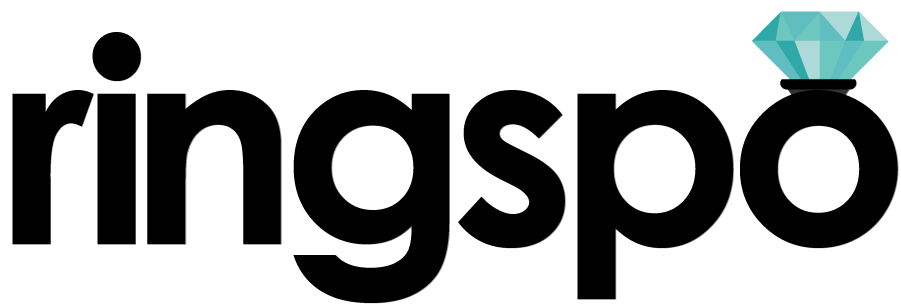Emerald Engagement Rings
Good enough for The Wizard of Oz, good enough for you?
Ringspo is reader supported
Ringspo is reader-supported, which means we may receive a commission if you click a link to a retailer & subsequently make a purchase.
We feature links to several retailers to help readers find the one that is the best fit for them. Find out more about how Ringspo works here.
Emerald engagement rings are increasingly popular as people look for less predictable alternatives to diamonds.
In this post I’m going to talk to you about everything you really need to know about buying an emerald engagement ring. I’ll strip out the irrelevant and keep it to actionable info that will help you get a great ring and not get hoodwinked along the way.
Emerald engagement rings do come with a word of warning, which I’ll cover in the ‘what’s not so good’ section of this page.
Let’s go!
What are Emeralds?
Without getting too Wikipedia-esque, I wanted to give you a quick rundown on what emeralds actually are before we jump into how to find the right emerald ring for you.. I’ll make this quick and try and keep it as interesting as possible.
Emeralds are actually a variety of the stone beryl which have been colored green by tiny amounts of chromium in their chemical make-up. The chromium in their chemical make-up means that emeralds don’t just reflect light, they also radiate it, making them appear even greener.
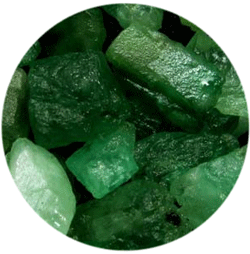
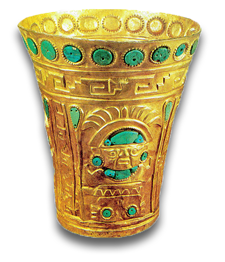
Inca cup with emerald inlays
The major source is emeralds is Colombia, where emeralds have been mined since Incan times. The global emerald trade developed during the 16th century after the Spanish Conquistadors captured the Inca Empire. They exported Colombian emeralds to Europe and the Philippines, and they also found their way to India, where they became one of the Maharaja’s favorite stones.
Other sources of emeralds include Zambia (where the stones are typically darker and more blue), Brazil (typically lighter and more yellow) Tanzania (very high quality). No matter where they are mined though, almost every emerald in the world is then taken to Jaipur in India, known as the Emerald Capital of the World, where they are cut and polished.
The amount of chromium affects how green an emerald is – if there is too little and the stone is a very light green then it is demoted from being called an emerald to just plain old ‘green beryl’. Equally, if there’s too much chromium an emerald may be very dark, which is also undesirable.
If beryl contains minerals other than chromium it can result in stones that we call different names, like the morganite, aquamarine and heliodor on the right. Other varieties of beryl can be just as desirable, if not more so than emerald, and command higher prices.
So that’s what emerald actually is. And as a center stone it has become much more popular in recent years as people look for a more individual and more interesting alternative to diamonds.
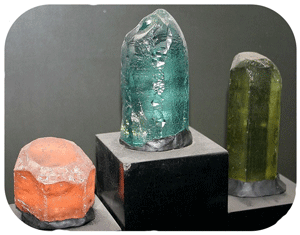
What’s good about emeralds?
Size
Emeralds have a lower density than diamonds, which means that for a given carat weight, an emerald is significantly larger.

While diamonds also need to be cut to certain proportions to ensure that as much light as refracted internally and bounced back to your eyes, emeralds don’t need to worry about this. This means that emeralds can be cut wider, rather than deeper, making them look larger.
Individuality
The other big advantage of emeralds as an engagement ring choice is that you are much less likely to encounter someone with the same ring as you, or even a similar ring.
While 75% of engagement rings sold have a round brilliant cut diamond, emeralds make up around 3% of engagement rings sold. By being thoughtful with your combination of stone cut shape and ring setting style you can ensure that you choose a ring that is totally tailored to you.
What’s not so good about emeralds?
Fragility
Gemstones (in fact, all materials) are measured on a scale of hardness, called ‘Moh’s scale’ with a perfect 10 being a diamond. Diamonds are the hardest material out there – the young Mike Tyson of the precious gem world.
Emeralds score around 7.5 on Moh’s scale – more of a slightly over-the-hill Rocky V era Rocky kind of rock.
This is important because an engagement ring is usually worn every day and will inevitably suffer a few knocks. With a softer stone, like an emerald, this could result in chips or even a completely broken stone.
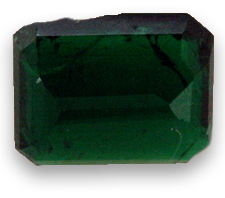
So, you’ll need to have a think about the person who is going to be wearing the ring. If she is the very picture of feminine grace (I’m sure she is!), then you might be able to get away with it. However, if she is likely to suffer the odd drunken tumble out of a taxi then I’d recommend going with a stone other than an emerald. Rubies and sapphires both score 9 on Moh’s scale and are considerably more resilient than an emerald.
Emerald buying guide
Emeralds, like all gemstones, are assessed using the ‘Four Cs’, which you may have heard of before, but then they are also given an overall grade with a letter. The Four Cs are:
- Cut
- Color
- Clarity
- Carat
We’ll look at each of the four Cs in turn and then the overall grading system at the end of this section. Each type of gemstone places a different level of importance on the four Cs, and while for diamonds cut is the most important, with emeralds it is definitely color, so we’ll start with that one.
EMERALD COLOR
An emerald’s color is the major factor that determines its quality and its price. The most sought after emeralds are a vivid green, with colour spread evenly over the stone.
However, the grading system is a bit more complicated than that and is actually split out into several factors:
- Hue – Hue is basically what you would normally understand as the color. As we discovered earlier, emeralds are actually the green form of the rock beryl so the hue of emeralds is primarily green. However, if you’re examining an emerald you may also pick up some secondary colours that can be seen when moving the stone in the light – Colombian emerald are more likely to be bluish green, which is generally thought to be more desirable than the yellow-ish green that some stones exhibit.
- Tone – is the scale from light to dark. You should look for something in the ‘medium’ tone which will give a good green, but also not be too dark to sparkle.
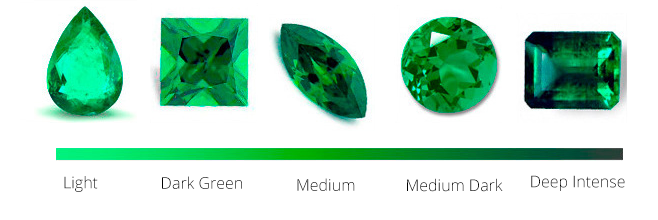
- Saturation – is the strength or intensity of the color. Darker emeralds may appear dull or “flat”, which makes them less vivid. By contrast, lighter emeralds are more likely to appear vivid green and appear ‘lively’.
- Purity – some emeralds have shades of grey or brown within them, which you should avoid. You want a stone that is pure green
While the emeralds that many people think are the most desirable, and therefore most expensive emeralds and therefore are those with high saturation and a tone between Medium and Medium Dark, it doesn’t necessarily mean that this color is the best for you. As emerald colour is so varied, it’s always a good idea to check out a few emeralds to see which ones float your boat.
EMERALD CLARITY
Clarity is a measure of the quality of the stone itself, and for emeralds there are two things that you need to look at:
- Flaws and imperfections
- Transparency
Flaws are also known as ‘inclusions’ and are a natural part of the emerald formation process – other minerals snuck in and the emeralds formed around them, leaving tiny bits of the intruding mineral still visible.
With some stones, like diamonds, you’re looking for a stone that has no visible imperfections at all. However, pretty much every emerald found, and definitely all of the ones that mere mortals like us can afford, will have some visible ‘flaws’ in them.
In fact, there’s even a term for the pattern of inclusions that emeralds have, the ‘jardin’, which is French for ‘garden’, because they can look like plant foliage.
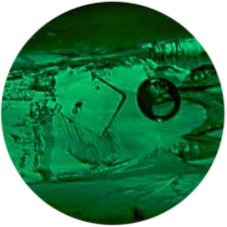
inclusion in emerald
The official scale for rating emeralds comes from the Gemological Institute of America:
- VVS (Very, Very Slightly Included): inclusions that are identifiable when a microscope or jeweler’s magnified loupe is used, but not to the naked eye.
- VS (Very Slightly Included): inclusions are obvious with magnification and can be seen by the naked eye.
- Sl1 and Sl2 (Slightly Included): prominent inclusions that are obvious to the naked eye.
- I1, I2, and I3 (Included): inclusions that are large enough to potentially negatively affect the gemstone’s appearance and durability.
Reading the grading scale, you should steer clear of any flaws that reduces the emerald’s durability – any cracks along the surface or that look like they run deep through the stone should definitely be avoided.
You want to avoid any flaws that make the color of the stone less uniform. Color is all-important with emeralds, so any dark spots will reduce the value of the stone significantly.
Transparency is the second clarity factor that you need to consider when buying an emerald engagement ring. The ideal is for light to easily pass through the stone without getting milky or cloudy – ideally you should be able to read a newspaper through the stone.
This can be affected by both colour and inclusions so it’s a good thing to look at to make sure that you’re spot on with both. But transparency is much harder to judge on rings that are already in settings, and is more something to look at if you are buying a loose emerald with a view to having it custom-mounted in a setting.
Treatments and enhancements
Applying treatments to emeralds to improve their appearance is pretty much par for the course emeralds and it’s very unlikely that any that you look at will not have been treated in some way. I’m going to quickly take you through which are OK and which you should avoid.
Oiling – the most common treatment is the application of natural cedar oil to an emerald, which is then heated. The oil fills some of the crack on the surface of the stone, improving their durability and the appearance of the stone. This is accepted and the use of natural cedar oil is extremely widespread.
Some jewelers now use other materials to fulfill this same function – green-coloured resin and plastic polymers are common. These are generally not accepted by the industry as they can change color over time, making the treatments much more obvious so should be avoided.
All treatments should be included on the certification that you receive with a stone, with the level of treatment being noted as minor, moderate or significant, with less treatment meaning a stone is worth more.
One thing to note about oiling is that it isn’t permanent. After a few years the stone may need to be re-oiled, which you will need to hut up an emerald specialist for.
Another thing to know is that ultrasonic cleaners that many jewelers use to clean jewelry can dislodge any filler used in emeralds, so emerald engagement rings should never be cleaned using an ultrasonic cleaner.
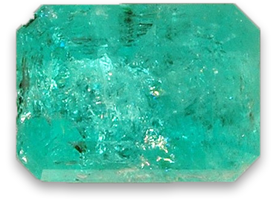
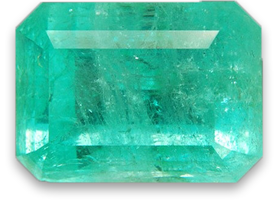
Emerald shapes and cut quality
Because they are fragile, emeralds are difficult to cut well. Jewelers try to cut them minimise the visibility of flaws, but also need to be careful to not crack the stone along the line of a surface imperfection.
While diamonds come in a wide variety of shapes, emeralds come in three main main shapes – the emerald cut, the round and the oval. While you can find them in any of the other stone cuts that are out there, these are the three that you’re most likely to encounter when looking for a ring.
Emerald-shaped emeralds
Emerald cuts can be either square or rectangular when viewed from the top and both have a stepped cut down the side of the stone and the corners trimmed off.
The corners are trimmed to help with the mounting of the stone in the ring and because without a sticky-outy corner, the stone is less likely to get knocked on something and break.
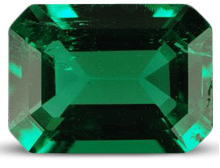
Round Cut emeralds
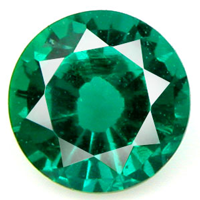
Round cuts are a popular shape at the moment, but are likely to be significantly more expensive than a similarly sized emerald-cut stone.
Knocking all of the edges off an emerald to make it round results in a lot of the stone being lost to wastage. So, to get a similarly sized round emerald to a emerald-cut emerald, you need to have started with a larger, and more expensive stone to begin with.
Oval-cut emerald
The big advantage of oval cuts is the impression of size that they give. They can be cut quite shallow, which means more of the carat weight is spread out over a wider area. Creating an oval cut emerald also includes less wastage than a round cut, so prices are usually lower.
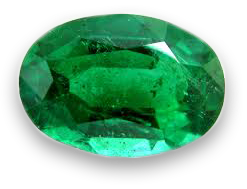
Emerald carat weight
Gemstone are usually measured in carats, with one carat being roughly 0.2 grammes. However, because gemstones all have different densities and therefore different sizes at the same carat weight, size is also often given in mm.
Emeralds have a relativity low density compared to diamonds, rubies or sapphires. This means that a lower carat rating will actually be bigger than the equivalent in another stone. Result!
But when you’re looking at a stone, to make it easier to compare stones against each other, you should be asking about the ‘price per carat’, rather than just the price. This will allow you to see how differences in colour and clarity between the stones are affecting the price, as well as the difference in size.
And the last thing is to watch out for if you’re quoted ‘total carat weight’. If there are several stones on a ring, the total carat weight will be the total weight for all of the stones. You should be talking about only the main stone when you’re discussing the price.
Emearald overall ‘grades’
Those are the Four Cs of emeralds, but unlike in diamonds which are relatively easy to grade consistently, emeralds are much more difficult. Emeralds are therefore given an overall grade to make it easier for consumers to understand what they’re getting.
AAA emeralds
AAA gemstones are the top 10% of emeralds in terms of quality. They are rich green, moderately to slightly included and exhibits high brilliance. They will make excellent center stones for engagement rings, although are priced accordingly.
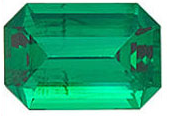
AA emeralds
AA are the top 20%-30% of gemstones. They are usually medium green and very slightly included. They are less suitable for the center stones of rings, but work well as smaller supporting stones.
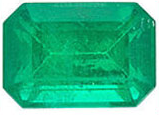
A grade emeralds
A grade emeralds are darker green, quite opaque and usually have some inclusions which are fairly easy to see with the naked eye. Price will be much lower and I wouldn’t recommend for a large center stone of an engagement ring.
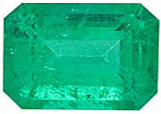
B grade emeralds
B grade stones are darker and more opaque still and have more obvious inclusions. They are more suitable for smaller gemstones in jewelry, like the channel stones in a channel engagement ring setting.
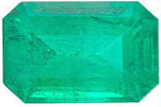
Emerald certification
A gemstone grading report, or ‘certification’, is a piece of paper to say that the stone has been examined and graded, usually by an independent authority. For those buying a diamond, it’s an essential part of the purchase: it lets them know that what they are buying is the quality that they are paying for.
As well as listing the size, shape, color and transparency of a stone, a grading report should also list any treatments that have been applied to the stone. One thing that a grading report doesn’t include is a value – that is dependent on the market conditions at the time. A similar report that is conducted to ascertain the value of a stone or of an engagement ring is known as an ‘appraisal’, which are often conducted for insurance purposes.
With emeralds though, it’s not always possible to ensure that your stone has been graded by an independent authority as not all jewelers and retailers accept the grading system.
Ideally it’s an independent lab like Gemological Institute of America (GIA) or American Gem Trade Association (AGTA) that you should be looking for. However, with some retailers you may need to accept the grade that has been given to a stone by the retailer themselves, following an assessment by their in-house gemologists.
Emerald engagement ring settings
The setting of the ring is how it sits on the band, and emeralds are sold in a wide range of setting styles. I’ve included a range of settings in this section, but there are many, many more available. If any of them tickle your fancy then click through to see more, or use my ring search tool to find the ring that is perfect for you.
Starting with the a classic emerald-cut emerald in a four-prong solitaire setting, this ring allows the center stone to be shown off with no distractions.
It’s important that a setting like this covers the fragile corners, and extending out to the sides and above the center stone offer it a measure of protection.
Emerald solitiare engagement ring
Check out all emerald engagement rings at Gemvara
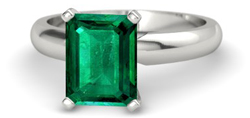
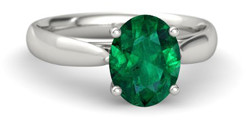
The oval cut is another popular cut for emeralds. It allows for excellent ‘spread’ i.e. the stone has as large a surface area as possible, which makes it looks larger for a particular carat size.
Adding pavé diamonds to the band of a ring is a great way to combine the sparkle of diamonds with the class of an emerald center stone.
This ring has diamonds set into the band, but also into the sides of the basket, to ensure that it will sparkle brilliantly from any angle. Click to see more details.
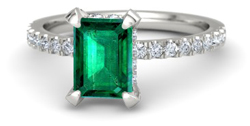
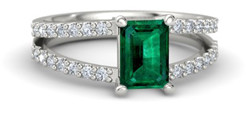
Variations to a band style can make a ring much more individual. This setting features two individual pavé bands which join at the bottom. The extra sturdiness that this wider setting offers makes it a great choice for a larger emerald.
Adding side stones to a ring can be a good way to make sure that the center stone doesn’t need to do all of the impressing on its own. Adding smaller side stones can be a good way of upping the carat count of a ring, without the increase in price that a big increase in the center stone would cost. Diamond side stones are a great way to complement a center emerald.
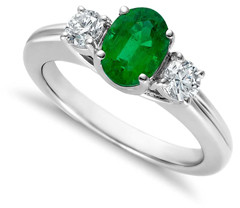
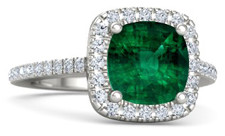
Another excellent way to support a center stone and to make a ring more impressive is to add a halo to it. As well as adding some size to the ring and a large amount of sparkle, a halo setting can also give an emerald engagement ring a measure of protection, as it shields the emerald from knocks.
Taking this one step further is this five stone emerald halo ring, which has five emeralds which each measure 4.5mm across and then a total of 56 diamonds set into the halo, for a total diamond carat weight of over half a carat.
Five stone halo emerald engagement ring
Check out more gemstone engagement rings at Blue Nile
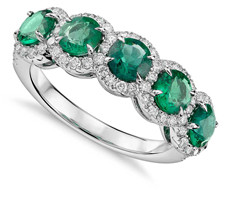
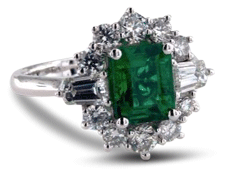
Emeralds are a great option for vintage style rings, as this vintage-style halo ring with additional baguette diamond side stones shows.
Vintage-style halo emerald engagement ring with baguette diamond side stones
This ring is a recreation in emerald of the sapphire ring that Prince William gave to Princess Kate. The ring is named the ‘Diana’ as the Princess Kate’s ring was originally owned by Prince William’s mother, Diana Princess of Wales.
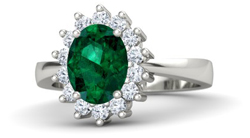
Emeralds were originally paired with yellow gold, rather than white settings, and the warmth of the yellow gold can complement an emerald perfectly.
One thing to watch out for with lighter stones though is that yellow gold can make a emerald look more yellow, which is something that you should avoid.
Combining a halo and variations on the ring’s band can also create interesting and individual rings. This ring has a pavé ‘infinity knot’ setting, where the rings band has been woven into a shape intended to resemble the infinity symbol, echoing the lifelong commitment that an engagement ring signifies.
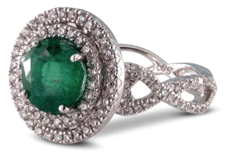
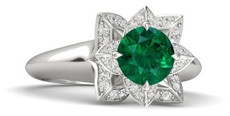
The variety of settings available mean that there’s an emerald engagement ring that is suitable for everyone. This floral halo engagement ring has a extremely pretty and feminine feel while also channeling a distinct vintage vibe.
Harking back to a bygone era when men wore tartan skirts, painted their faces blue and shouted about ‘freeeedoooooom’ a lot, this antique-inspired emerald engagement ring is brimming with celtic charm.
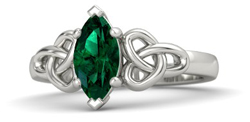
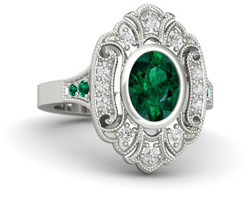
We’ll finish this section up with another vintage-style ring, this intricate design was inspired by the scrollwork and lacing of the Edwardian Era.
Bonus point: it’s named the ‘Arya’, after everyone’s favourite surviving Stark child.
Vintage ‘Arya’ halo emerald engagement ring
Check out all emerald engagement rings at Gemvara
